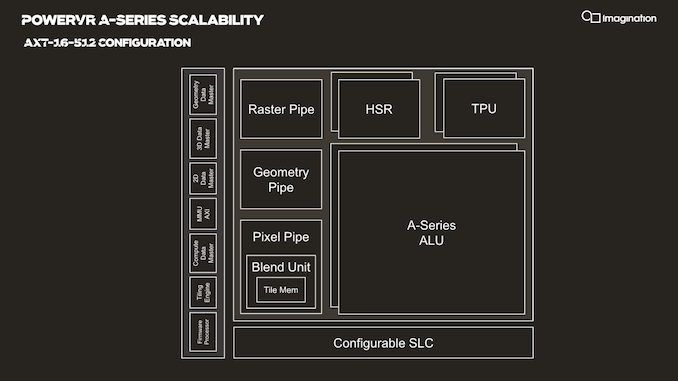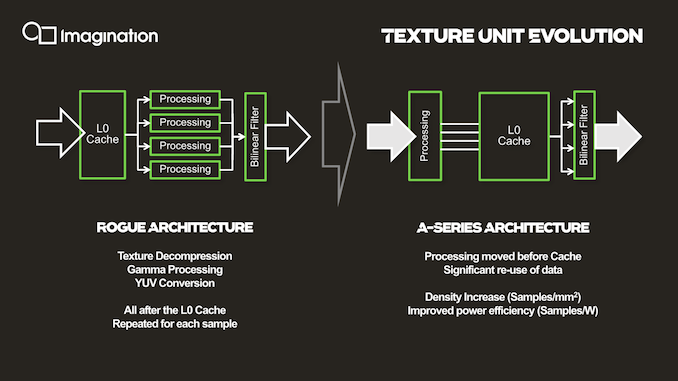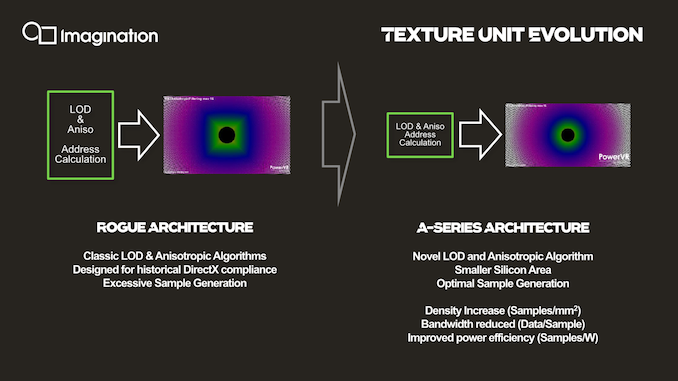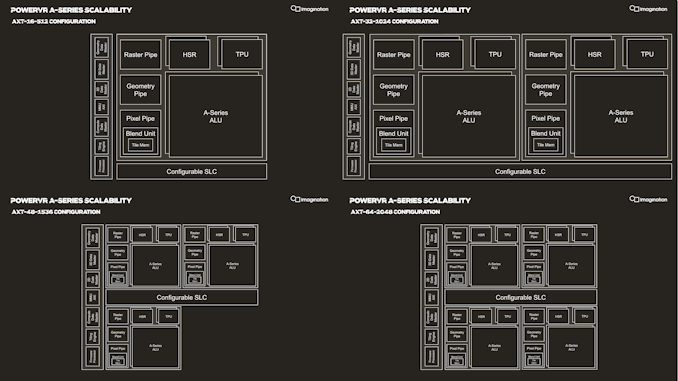Imagination Announces A-Series GPU Architecture: "Most Important Launch in 15 Years"
by Andrei Frumusanu on December 2, 2019 8:00 PM ESTFixed Function Changes & Scalability
Zooming out from the ALU, we’re seeing a higher-level block configuration that’s very similar to past Imagination PowerVR GPUs. The ALUs themselves are still housed in the larger cluster block that’s called the USC, or unified shading cluster. The USC along with various other fixed function blocks is in turn housed in an SPU, or shader processing unit, effectively the scaling block regularly referred to as a “core”.
Each SPU houses two USCs in the current IP configuration, meaning we have two clusters of 128-wide ALUs. This is valid for all AXT parts, but we imagine the AXM-8-256 unit just has a single USC. The AXT-16-512 is the smallest configuration with a fully populated SPU.
Each SPU has its own geometry pipeline, and up to two texture processing units. The A-Series carries over the per-TPU throughput design from the Furian architecture, meaning the block is able to sample 8 bilinear filtered texels per clock. The A-Series doubles this up now per SPU and the AXT models feature two TPUs, bringing up the total texture fillrate to 16 samples per clock per SPU.
The microarchitecture of the texture units has also evolved beyond just their throughput. A bigger improvement that Imagination is disclosing is the handling and location of the L0 cache. The L0 cache has been relocated within the texturing workflow to between the processing and filtering stages, allowing the L0 cache to hold the outputs of the processing stage, rather than the inputs. This allows for what Imagination calls significant data reuse, as texels don't need to be re-processed each time they're needed. And given how many times a texel may need to be sampled during anisotropic filtering, it's easy to see why. With the benefit of hindsight, this seems like an obvious improvement to make, but the company says that the design choices of the legacy configuration made sense at the time of conception and the workloads back then.
Imagination also talks about how the anisotropic filtering quality of the new architecture is much improved. In a set of comparison screenshots using a traditional texture tunnel, Imagination is showcasing that its new anisotropic filtering algorithms are far closer to being angle-independent – the ideal outcome for aniso filtering – as opposed to angle-dependent filtering with rather hard 90 degree angles on Rogue. Interestingly, Imagination is claiming that they've achieved this improved angle-independence even with fewer fewer samples, all of which serves to improve their efficiency and hardware density. With all of that said, since the comparison is against the Rogue architecture, I’m not entirely sure if it’s an actual novelty of the A-Series or rather a rehash of the anisotropic improvements that already got introduced in the 9XM series last year.
Another change in the fixed function units is found in the pixel pipeline, although superficially the throughput here doesn’t change compared to what we’ve seen on Furian. There’s still up to two PBEs with throughputs of up to 4 pixels per clock, and the design houses two such units for a total of 8 pixels per clock per SPU. There’s actually more internal distinction of the units though – at the front and back core it’s still able to handle 16 pixels per clock and also blend at 16 pixels per clock, although it’s limited on write out to 8 PPC on 1:1 pixel:texture situations.
Imagination’s doubling of the texture throughput whilst maintaining a steady pixel throughput means that the company is generally matching the decreasing pixel:texel fillrate throughput ratio we’ve also seen in other architectures such as from Qualcomm as well as the new Mali-G77, and now falls in at a 1:2 pixel:texel for the A-series.
Alpha blending is now done on a dedicated hardware unit in the pixel pipeline instead of being computed by the ALUs. The change results in higher performance through the use of fixed function hardware, allowing for things such as FP16 blending at full rate, and frees up the ALUs themselves so that they can use their computation resources on other work. Density is improved, but more importantly it’s also improving power efficiency as it’s avoiding using more expensive and less task-specific hardware for the same tasks.
It’s to be noted that for the AXM series, the company uses customized fixed function units that are more area efficient, rather than just only scaling the numbers of units.
Scaling Things Up
With the SPU being the coarsest scaling block of the architecture, Imagination is building larger GPU configurations by simply adding in more SPUs. Essentially this is the “core” scaling of Imagination's GPU designs.
Scaling of SPUs across the AXT line happens in multiples of 16-512 across the range, both in terms of their product names as well as their texture and FLOPs/clock capabilities, which is rather simple to grasp and very quickly understand a configuration’s capabilities. As mentioned in the introduction, Imagination views the AXT-32-1024 as being the most popular choice for vendors targeting the high-end premium smartphone SoC segment, which possibly some vendors opting to go with the AXT-48-1536 for a larger area and lower clock speeds for more efficiency. The AXT-64-2048 would be a really big GPU which the company could build if there’s costumer interest.
| PowerVR GPU Comparison | ||||
| AXT-16-512 | GT9524 | GT8525 | GT7200 Plus | |
| Core Configuration |
1 SPU (Shader Processing Unit) - "GPU Core" 2 USCs (Unified Shading Clusters) - ALU Clusters |
|||
| FP32 FLOPS/Clock MADD = 2 FLOPs MUL = 1 FLOP |
512 (2x (128x MADD)) |
240 (2x (40x MADD+MUL)) |
192 (2x (32x MADD+MUL)) |
128 (2x (16x MADD+MADD)) |
| FP16 Ratio | 2:1 (Vec2) | |||
| Pixels / Clock | 8 | 4 | ||
| Texels / Clock | 16 | 8 | 4 | |
| Architecture | A-Series (Albiorix) |
Series-9XTP (Furian) |
Series-8XT (Furian) |
Series-7XT (Rogue) |
Comparing the smallest AXT-16-512 configuration with a single SPU and two USCs against similar configurations across the generations, we indeed see that the new A-Series does bring large architectural changes.
Imagination is marketing a 4x increase in ALU throughput, but again that’s against the 9XM GPUs, which are equal in ALU configuration to the Series-7XT in the table. However, it’s not to say that the increases aren’t any less impressive when comparing to the previous 9XTP family; a rise from 240 FLOPs/clock to 512 is still a 2.13x increase.
I think what’s actually more important to note here is the architecture has very big building blocks. At 512 FLOPs and 8 pixels per clock, an AXT SPU is significantly bigger than an Arm Mali-G77 core which comes in at “only” 64 FLOPs/clock and 2 pixels per clock, meaning an AXT core is roughly equivalent to eight G77 cores in computational power and four G77s in fillrate throughput, which is a massive difference in terms of design scaling. Naturally, in terms of effective density and power efficiency, few big cores will always win over a flock of small cores, as demonstrated by Qualcomm and Apple’s recent 2- and 4-core designs.















143 Comments
View All Comments
s.yu - Wednesday, December 4, 2019 - link
"Apple is the biggest example of what a toxic system capitalism can become. "Clear sign of a hater, vlad.
"Huawei is the biggest example of what a toxic system state capitalism-cum-corrupt monarchy can become. "
It could direct authorities to jail an individual for 251 days with false testimonies only to be proven innocent and compesated with a recording he kept, and those who lied under oath are never held accountable.
Huawei could frame somebody, to be jailed using the state apparatus supported by taxpayers, to be compensated using tax money when proven innocent, without expending a single cent from its pocket or giving so much as single apology when exposed. Yeah that's so much better than Apple.
Korguz - Wednesday, December 4, 2019 - link
he's right apple does charge way to much for their products. all apple cares about.. is its profits....Threska - Wednesday, December 4, 2019 - link
Who isn't selfish? Companies care about profits. Consumers care about the lowest price.Korguz - Wednesday, December 4, 2019 - link
not like apple does.. their stuff is very overpriced....s.yu - Wednesday, December 4, 2019 - link
https://www.sixthtone.com/news/1004918/huawei-is-i...Everybody who has idealistic views of Huawei should be reading this, vlad accuses me of being a hater and look what he's doing.
s.yu - Wednesday, December 4, 2019 - link
No shit that was 404'd.https://www.bbc.com/news/technology-50658787
This is a BBC article but with much fewer details.
s.yu - Wednesday, December 4, 2019 - link
Key points here:1. Huawei's HR lead a few employees to lie under oath to start the investigation against him.
2. Authorities had the choice between detaining him and not detaining him, all they had to go on was Huawei's testimonies, they detained him siding with Huawei despite circumstantial evidence that the accusations were likely false.
3. He was investigated due to another false accusation from Huawei a few months in for an extension on his jail time.
4. Another employee was jailed under similar circumstances but gave in and wrote a confession under Huawei's promise no to press charges, which Huawei immediately seized, and brought to court.
5. He only discovered the reason to jail him when he met his lawyer appointed by his wife, which was already months into his effective sentence, only then did he disclose that he had a recording of his discussion with the company regarding compensations(and multiple backups, some of which survived police search during his arrest), which proved his innocence.
6. Upon procecutors terminating investigations on revelation from the recording and releasing him with compensation from the state, Huawei immediately modified their testimony.
7. There was never an apology nor compensation from Huawei for framing Li, not in an official capacity, not by the employees and the HR who gave the false testimonies, and the individuals who lied under oath were never prosecuted nor even investigated.
8. In the first 2-3 days of the incident there was intense censorship, to a scale probably unimaginable by an outsider, but as the Party realized this could not be suppressed, which brings us to where we are now. They turned to attempting to dictate the public discourse with censored reports and obfuscated details, and encouraging the spread of effectively irrelevant content defending Huawei from ideological and emotional standpoints.
ksec - Tuesday, December 3, 2019 - link
That assumes the drivers from IMG or Vendors could make their GPU perform as fast as it could.mode_13h - Wednesday, December 4, 2019 - link
Only because they refuse to open source (or publish details to support open source driver development).lucam - Tuesday, December 3, 2019 - link
Do not forget there is also the AXT-48-1536 for premium mobile that should go even faster than the 1024 and therefore easily compete with the future A14